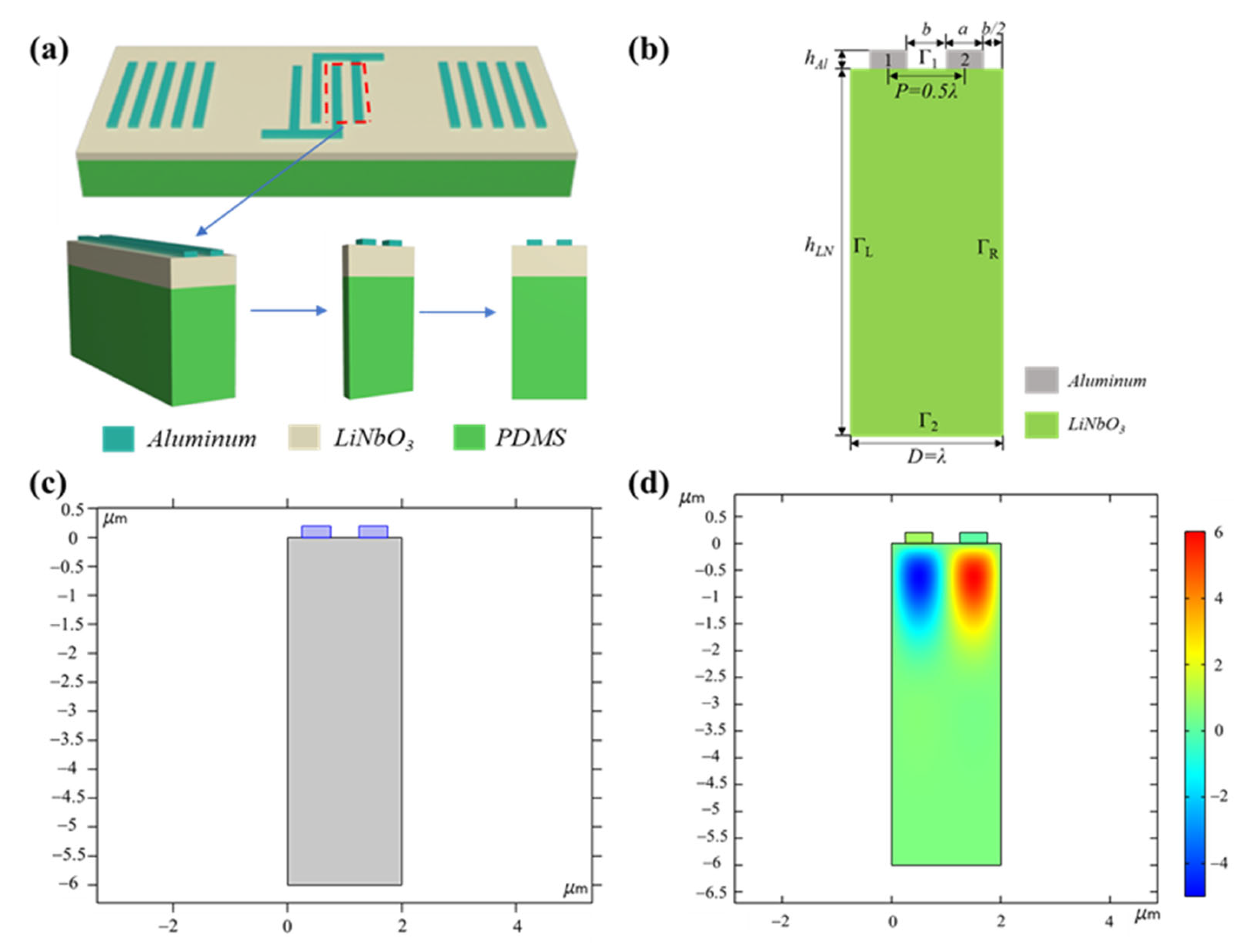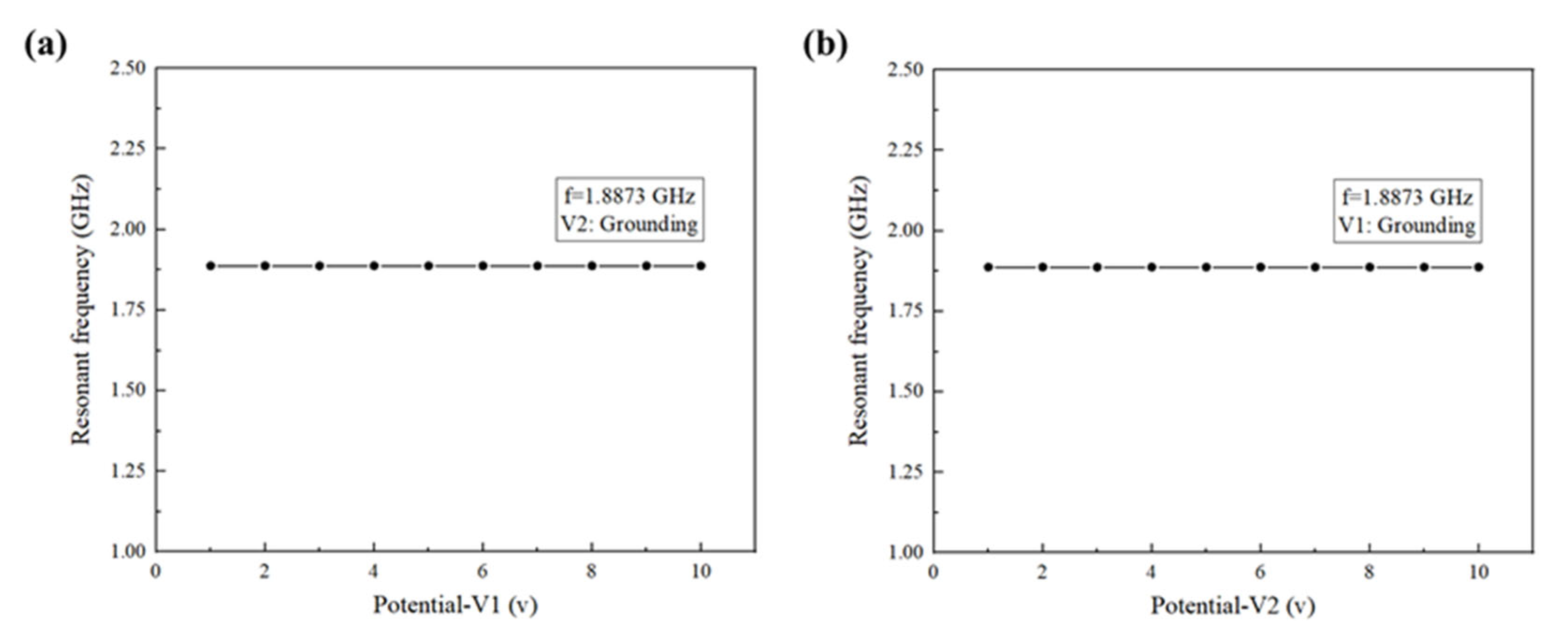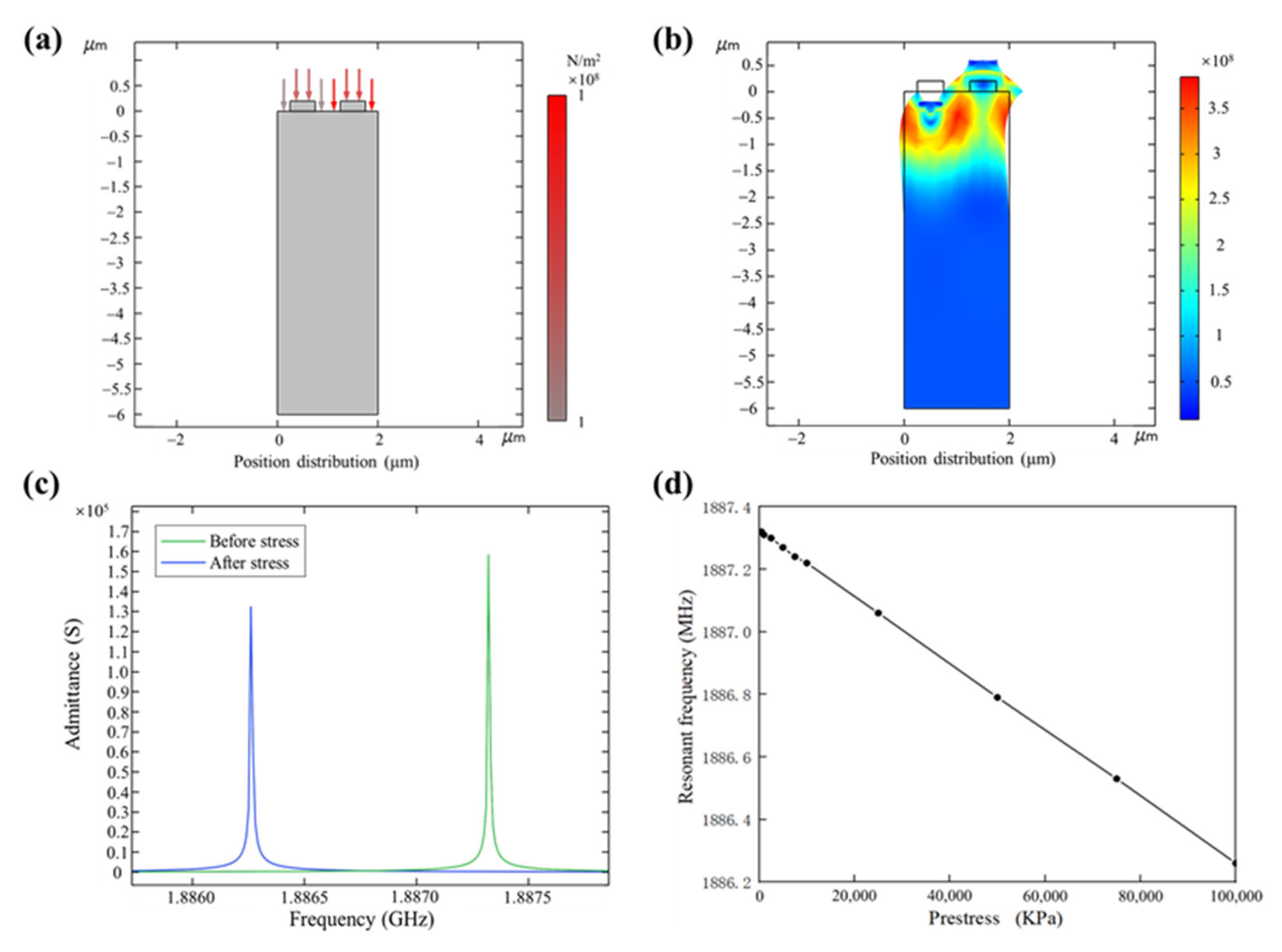Finite Element Analysis Model of Electronic Skin Based on Surface Acoustic Wave Sensor
Abstract
1. Introduction
2. Materials and Methods
2.1. SAWS Principle
2.2. Finite Element Simulation Model
2.2.1. E-Skin Model
2.2.2. SAWS Simulation Model
3. Parameter Characteristics of SAWS
4. Application
4.1. Stress and Strain
4.2. Temperature
4.3. Concentration
5. Conclusions
Author Contributions
Funding
Institutional Review Board Statement
Informed Consent Statement
Data Availability Statement
Acknowledgments
Conflicts of Interest
References
- Lee, Y.; Chung, J.W.; Lee, G.H.; Kang, H.; Kim, J.Y.; Bae, C.; Yoo, H.; Jeong, S.; Cho, H.; Kang, S.G.; et al. Standalone real-time health monitoring patch based on a stretchable organic optoelectronic system. Sci. Adv. 2021, 7, eabg9180. [Google Scholar] [CrossRef] [PubMed]
- Kim, D.H.; Ahn, J.H.; Won, M.C.; Kim, H.S.; Kim, T.H.; Song, J.; Huang, Y.Y.; Liu, Z.; Lu, C.; Rogers, J.A. Stretchable and foldable silicon integrated circuits. Science 2008, 320, 507–511. [Google Scholar] [CrossRef] [PubMed]
- Tian, L.; Zimmerman, B.; Akhtar, A.; Yu, K.J.; Moore, M.; Wu, J.; Larsen, R.J.; Lee, J.W.; Li, J.; Liu, Y.; et al. Large-area MRI-compatible epidermal electronic interfaces for prosthetic control and cognitive monitoring. Nat. Biomed. Eng. 2019, 3, 194–205. [Google Scholar] [CrossRef]
- Chung, H.U.; Kim, B.H.; Lee, J.Y.; Lee, J.; Xie, Z.; Ibler, E.M.; Lee, K.H.; Banks, A.; Jeong, J.Y.; Kim, J.; et al. Binodal, wireless epidermal electronic systems with in-sensor analytics for neonatal intensive care. Science 2019, 363, eaau0780. [Google Scholar] [CrossRef] [PubMed]
- Gao, W.; Emaminejad, S.; Nyein, H.Y.Y.; Challa, S.; Chen, K.; Peck, A.; Fahad, H.M.; Ota, H.; Shiraki, H.; Kiriya, D.; et al. Fully integrated wearable sensor arrays for multiplexed in situ perspiration analysis. Nature 2016, 529, 509–514. [Google Scholar] [CrossRef] [PubMed]
- Son, D.; Lee, J.; Qiao, S.; Ghaffari, R.; Kim, J.; Lee, J.E.; Song, C.; Kim, S.J.; Lee, D.J.; Jun, S.W.; et al. Multifunctional wearable devices for diagnosis and therapy of movement disorders. Nat. Nanotechnol. 2014, 9, 397–404. [Google Scholar] [CrossRef] [PubMed]
- Demidenko, N.A.; Kuksin, A.V.; Molodykh, V.V.; Pyankov, E.S.; Ichkitidze, L.P.; Zaborova, V.A.; Tsymbal, A.A.; Tkachenko, S.A.; Shafaei, H.; Diachkova, E.; et al. Flexible strain-sensitive silicone-CNT sensor for human motion detection. Bioengineering 2022, 9, 36. [Google Scholar] [CrossRef]
- Fu, Y.; Wang, N.; Yang, A.; Law, H.K.; Li, L.; Yan, F. Highly sensitive detection of protein biomarkers with organic electrochemical transistors. Adv. Mater. 2017, 29, 1703787. [Google Scholar] [CrossRef]
- Kim, Y.; Suh, J.M.; Shin, J.; Liu, Y.; Yeon, H.; Qiao, K.; Kum, H.S.; Kim, C.; Lee, H.E.; Choi, C.; et al. Chip-less wireless electronic skins by remote epitaxial freestanding compound semiconductors. Science 2022, 377, 859–864. [Google Scholar] [CrossRef]
- Jonsson, B. An empirical approach to finding energy efficient ADC architectures. In Proceedings of the 2011 International Workshop on ADC Modelling, Testing and Data Converter Analysis and Design and IEEE 2011 ADC Forum, Orvieto, Italy, 30 June–1 July 2011. [Google Scholar]
- Vu, M.C.; Kim, I.H.; Choi, W.K.; Lim, C.S.; Islam, M.A.; Kim, S.R. Highly flexible graphene derivative hybrid film: An outstanding nonflammable thermally conductive yet electrically insulating material for efficient thermal management. ACS Appl. Mater. Interfaces 2020, 12, 26413–26423. [Google Scholar] [CrossRef]
- Gong, S.; Lu, R.; Yang, Y.; Gao, L.; Hassanien, A.E. Microwave acoustic devices: Recent advances and outlook. IEEE J. Microw. 2021, 1, 601–609. [Google Scholar] [CrossRef]
- Marinković, Z.; Gugliandolo, G.; Campobello, G.; Crupi, G.; Donato, N. Application of Artificial Neural Networks for Modeling of the Frequency-Dependent Performance of Surface Acoustic Wave Resonators. In Proceedings of the 2021 56th International Scientific Conference on Information, Communication and Energy Systems and Technologies (ICEST), Sozopol, Bulgaria, 16–18 June 2021; pp. 145–148. [Google Scholar]
- Gugliandolo, G.; Marinković, Z.; Campobello, G.; Crupi, G.; Donato, N. On the performance evaluation of commercial SAW resonators by means of a direct and reliable equivalent-circuit extraction. Micromachines 2021, 12, 303. [Google Scholar] [CrossRef] [PubMed]
- Koigerov, A.S. Modern physical-mathematical models and methods for design surface acoustic wave devices: COM based P-matrices and FEM in COMSOL. Mathematics 2022, 10, 4353. [Google Scholar] [CrossRef]
- Streque, J.; Camus, J.; Laroche, T.; Hage-Ali, S.; M’jahed, H.; Rammal, M.; Aubert, T.; Djouadi, M.A.; Ballandras, S.; Elmazria, O. Design and characterization of high-Q SAW resonators based on the AlN/sapphire structure intended for high-temperature wireless sensor applications. IEEE Sens. J. 2020, 20, 6985–6991. [Google Scholar] [CrossRef]
- Alam, S.; Islam, T.; Mittal, U. A sensitive inexpensive SAW sensor for wide range humidity measurement. IEEE Sens. J. 2020, 20, 546–551. [Google Scholar] [CrossRef]
- Li, P.X.; Li, H.L.; Cheng, L.N.; Ke, Y.B.; Tian, Y.H. Strain sensitivity of epoxy-quartz packaged saw strain sensors. In Proceedings of the 2019 14th Symposium on Piezoelectricity, Acoustic Waves and Device Applications, SPAWDA, Shijiazhuang, China, 1–4 November 2019. [Google Scholar]
- Ma, J.; Mao, S.; Wang, L.; Tang, Y.; Li, Z.; Du, B.; Yang, J.; Jiang, H.; Ao, D.; Zu, X. Surface acoustic wave (SAW) ammonia gas sensor based on the ZnO nanorod array. Sens. Lett. 2016, 14, 673–677. [Google Scholar] [CrossRef]
- Li, Q.; Liu, J.; Yang, B.; Lu, L.; Yi, Z.; Tian, Y.; Liu, J. Highly sensitive surface acoustic wave flexible strain sensor. IEEE Electron Device Lett. 2019, 40, 961–964. [Google Scholar] [CrossRef]
- Yildirim, B.; Senveli, S.U.; Gajasinghe, R.W.R.L.; Tigli, O. Surface acoustic wave viscosity sensor with integrated micro-fluidics on a PCB platform. IEEE Sens. J. 2018, 18, 2305–2312. [Google Scholar] [CrossRef]
- Muller, A.; Konstantinidis, G.; Giangu, I.; Adam, G.C.; Stefanescu, A.; Stavrinidis, A.; Stavrinidis, G.; Kostopoulos, A.; Boldeiu, G.; Dinescu, A. GaN membrane supported SAW pressure sensors with embedded temperature sensing capability. IEEE Sens. J. 2017, 17, 7383–7393. [Google Scholar] [CrossRef]
- Yan, H.; Yang, X.; Liu, Y.; He, W.; Liao, Y.; Yang, J.; Gao, Y. Feasibility analysis and implementation of head-mounted electrical impedance respiratory monitoring. Biosensors 2022, 12, 934. [Google Scholar] [CrossRef]
- Mandal, D.; Banerjee, S. Surface acoustic wave (SAW) sensors: Physics, materials, and applications. Sensors 2022, 22, 820. [Google Scholar] [CrossRef]
- Grilli, S.; Vespini, V.; Ferraro, P. Surface-charge lithography for direct PDMS micro-patterning. Langmuir 2008, 24, 13262–13265. [Google Scholar] [CrossRef]
- Yeon, H.; Lee, H.; Kim, Y.; Lee, D.; Lee, Y.; Lee, J.S.; Shin, J.; Choi, C.; Kang, J.H.; Suh, J.M.; et al. Long-term reliable physical health monitoring by sweat pore–inspired perforated electronic skins. Sci. Adv. 2021, 7, eabg8459. [Google Scholar] [CrossRef] [PubMed]
- Effenhauser, C.S.; Bruin, G.J.; Paulus, A.; Ehrat, M. Integrated capillary electrophoresis on flexible silicone microdevices: Analysis of DNA restriction fragments and detection of single DNA molecules on microchips. Anal. Chem. 1997, 69, 3451. [Google Scholar] [CrossRef] [PubMed]
- Peterson, S.L.; McDonald, A.; Gourley, P.L.; Sasaki, D.Y. Poly(dimethylsiloxane) thin films as biocompatible coatings for microfluidic devices: Cell culture and flow studies with glial cells. J. Biomed. Mater. Res. 2005, 72A, 10. [Google Scholar] [CrossRef] [PubMed]
- Li, Z.; Meng, X.; Wang, B.; Zhang, C. A three-dimensional finite element analysis model of SAW torque sensor with multilayer structure. Sensors 2022, 22, 2600. [Google Scholar] [CrossRef]
- Peng, G.; Yang, C.; He, W.; Chen, C.L.P. Force sensorless admittance control with neural learning for robots with actuator saturation. IEEE Trans. Ind. Electron. 2020, 67, 3138–3148. [Google Scholar] [CrossRef]
- Caliendo, C. Acoustic wave conductometric sensors. Encycl. Sens. Biosens. 2023, 3, 591–616. [Google Scholar]
- Boute, R. The functional nature of units, with application to the decibel in propagation calculations [education corner]. IEEE Antennas Propag. Mag. 2021, 63, 131–139. [Google Scholar] [CrossRef]
- Raghib, A.A.B.M.R.M.; Nordin, A.N. Analysis of electromechanical coupling coefficient of surface acoustic wave resonator in ZnO piezoelectric thin film structure. In Proceedings of the DTIP 2014—Symposium on Design, Test, Integration and Packaging of MEMS/MOEMS, Cannes, France, 1–14 April 2014. [Google Scholar]
- Manenti, R.; Peterer, M.J.; Nersisyan, A.; Magnusson, E.B.; Patterson, A.; Leek, P.J. Surface acoustic wave resonators in the quantum regime. Phys. Rev. B 2016, 93, 041411. [Google Scholar] [CrossRef]
- Sessler, D.I. Perioperative thermoregulation and heat balance. Lancet 2016, 387, 2655–2664. [Google Scholar] [CrossRef] [PubMed]
- Wynants, L.; van Calster, B.; Collins, G.S.; Riley, R.D.; Heinze, G.; Schuit, E.; Bonten, M.M.J.; Damen, J.A.A.; Debray, T.P.A.; de Vos, M.; et al. Prediction models for diagnosis and prognosis of COVID-19: Systematic review and critical appraisal. BMJ 2020, 369, 29. [Google Scholar] [CrossRef] [PubMed]
- Baba, A.; Searfass, C.T.; Tittmann, B.R. High temperature ultrasonic transducer up to 1000 °C using lithium niobate single crystal. Appl. Phys. Lett. 2010, 97, 232901. [Google Scholar]
- Montain, S.J.; Cheuvront, S.N.; Lukaski, H.C. Sweat mineral-element responses during 7 h of exercise-heat stress. Int. J. Sport Nutr. Exerc. Metab. 2007, 17, 574–582. [Google Scholar] [CrossRef]
- Christodouleas, D.C. Can sweat sensors detect common diseases? A simple sweat patch may soon achieve it. Clin. Chem. 2019, 65, 1073–1075. [Google Scholar] [CrossRef]
- Nawaz, A.A.; Mao, X.; Stratton, Z.S.; Huang, T.J. Unconventional microfluidics: Expanding the Discipline. Lab. Chip 2013, 13, 1457–1463. [Google Scholar] [CrossRef]







| Name | Parameter |
|---|---|
| λ | 2 μm |
| a | 0.25λ (0.5 μm) |
| b | 0.25λ (0.5 μm) |
| P | 0.5λ (1 μm) |
| D | λ (2 μm) |
| hAl | 0.2 μm |
| hLN | 6 μm |
| Material | 128° Y-X LiNbO3 | |
|---|---|---|
| Density, ρ [kg/m3] | 4700 | |
| Relative dielectric constant, εrs | {epsilonrS11, epsilonrS22, epsilonrS33}; epsilonrSij = 0 | {43.6, 43.6, 29.16} |
| Coupling matrix, eES [C/m2] | {eES11, eES21, eES31, eES12, eES22, eES32, eES13, eES23, eES33, eES14, eES24, eES34, eES15, eES25, eES35, eES16, eES26, eES36} | {0, −2.53764, 0.193644, 0, 2.53764, 0.193644, 0, 0, 1.30863, 0, 3.69548, 0, 3.69594, 0, 0, −2.53384, 0, 0} |
| Elastic matrix, CE [1011 Pa] | {cE11, cE12, cE22, cE13, cE23, cE33, cE14, cE24, cE34, cE44, cE15, cE25, cE35, cE45, cE55, cE16, cE26, cE36, cE46, cE56, cE66}; cEij = cEji | {2.02897, 0.529177, 2.02897, 0.749098, 0.749098, 2.43075, 0.0899874, −0.0899874, 0, 0.599034, 0, 0, 0, 0, 0.599018, 0, 0, 0, 0, 0.0898526, 0.748772} |
| Material | Al (IDT) |
|---|---|
| Density, ρ [kg/m3] | 2700 |
| Young’s modulus, E [Pa] | 70 × 109 |
| Poisson’s ratio, µ | 0.33 |
| Boundary | Mechanical Conditions | Electrical Conditions |
|---|---|---|
| Γ1 | Free | Zero charge |
| Γ2 | Fixed | Ground |
| ΓL, ΓR | Periodic boundary conditions | Periodic boundary conditions |
| Electrode Number | Al (IDT) |
|---|---|
| 1 | +1 V |
| 2 | Grounding |
Disclaimer/Publisher’s Note: The statements, opinions and data contained in all publications are solely those of the individual author(s) and contributor(s) and not of MDPI and/or the editor(s). MDPI and/or the editor(s) disclaim responsibility for any injury to people or property resulting from any ideas, methods, instructions or products referred to in the content. |
© 2023 by the authors. Licensee MDPI, Basel, Switzerland. This article is an open access article distributed under the terms and conditions of the Creative Commons Attribution (CC BY) license (https://creativecommons.org/licenses/by/4.0/).
Share and Cite
Jiao, C.; Wang, C.; Wang, M.; Pan, J.; Gao, C.; Wang, Q. Finite Element Analysis Model of Electronic Skin Based on Surface Acoustic Wave Sensor. Nanomaterials 2023, 13, 465. https://doi.org/10.3390/nano13030465
Jiao C, Wang C, Wang M, Pan J, Gao C, Wang Q. Finite Element Analysis Model of Electronic Skin Based on Surface Acoustic Wave Sensor. Nanomaterials. 2023; 13(3):465. https://doi.org/10.3390/nano13030465
Chicago/Turabian StyleJiao, Chunxiao, Chengkai Wang, Meng Wang, Jinghong Pan, Chao Gao, and Qi Wang. 2023. "Finite Element Analysis Model of Electronic Skin Based on Surface Acoustic Wave Sensor" Nanomaterials 13, no. 3: 465. https://doi.org/10.3390/nano13030465
APA StyleJiao, C., Wang, C., Wang, M., Pan, J., Gao, C., & Wang, Q. (2023). Finite Element Analysis Model of Electronic Skin Based on Surface Acoustic Wave Sensor. Nanomaterials, 13(3), 465. https://doi.org/10.3390/nano13030465






